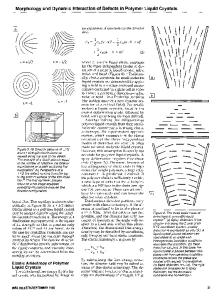Formation of Polymer Stabilized Ferroelectric Liquid Crystals using a Fluorinated Diacrylate
- PDF / 352,565 Bytes
- 6 Pages / 420.48 x 639 pts Page_size
- 109 Downloads / 271 Views
123
Mat. Res. Soc. Symp. Proc. Vol. 559 01999 Materials Research Society
unique to fluorinated monomeric species, the properties exhibited by these materials appear to be considerably different than those of analogous hydrocarbon species. Not only do perfluorinated groups have effects on monomeric and polymeric materials, but they also have a significant impact on the properties of other low molecular weight liquid crystalline (LC) materials. A number of interesting effects have been observed by using fluorinated LC tails as well as incorporating fluorine atoms in the mesogenic core of the LC. Often the fluorinated moieties induce self-assembly and various LC phases [3]. Because of the unique properties afforded by fluorinated LCs, they have been examined extensively for a wide array of applications. The use of fluorinated moieties in liquid crystals, therefore, has a significant impact on the properties of the material. Additionally, semifluorinated monomeric species may exhibit LC phases that potentially alter polymerization behavior. Another facet of these fascinating materials that has yet to be explored in detail is the introduction of a fluorinated polymer into a low molecular weight liquid crystal to form polymer/LC composites, and more specifically, polymer stabilized ferroelectric liquid crystals (PSFLCs). Enhanced reaction rates [4] and monomer segregation [5] are prevalent during the formation of these composites, and fluorinated moieties may provide additional insight and unique properties in PSFLC materials. The goal of this work is, therefore, to describe the effects of adding a fluorinated diacrylate to a ferroelectric liquid crystal (FLC) before, during and after polymerization. To accomplish this goal, the polymerization of small amounts of this fluorinated diacrylate dissolved in an FLC is examined at different polymerization conditions to explore the influence of temperature and liquid crystalline phase on the polymerization kinetics. The segregation of the monomer is also investigated to facilitate understanding of the observed polymerization behavior. Through these studies, a basis for exploring the possibility of taking advantage of the unique properties of fluorinated polymer networks in the formation of PSFLC materials will be developed and a greater knowledge of the processes involved in the polymerization of fluorinated species in ordered media will be attained. EXPERIMENTAL Materials The fluorinated diacrylate monomer chosen for study was octafluoro 1,6 hexanediol diacrylate (FHDDA). The FLC used was a 1:1 mixture of W82,W7 [4]. Chemical structures of the monomer as well as its hydrocarbon analog (1,6 hexanediol diacrylate) and the structure of the FLC molecules are shown in Figure 1. Photopolymerizations were initiated using Irgacure 907 from Ciba-Geigy. Procedure Reaction profiles were monitored with a differential scanning calorimeter (DSC) modified with a dual beam photocalorimetric accessory. Double bond conversion was then determined by integration of the rate curve. The DSC cell
Data Loading...











